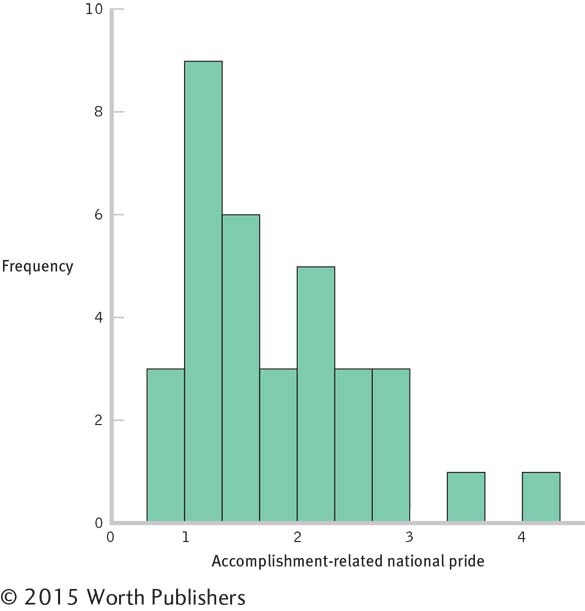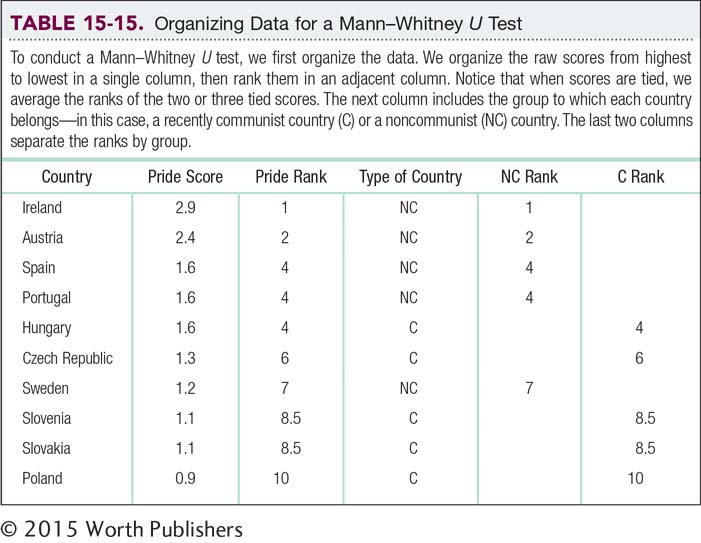15.3 Ordinal Data and Correlation
The statistical tests we discuss in this section allow researchers to draw conclusions from data that do not meet the assumptions for a parametric test, such as when the data are rank ordered. In this section, we learn how to convert scale data to ordinal data. Then we examine two tests that can be used with ordinal data: the Spearman rank-
When the Data Are Ordinal
A University of Chicago News Office press release proclaimed, “Americans and Venezuelans Lead the World in National Pride.” Researchers from the University of Chicago’s National Opinion Research Center (NORC) surveyed citizens of 33 countries (Smith & Kim, 2006) and developed two different kinds of national pride scores: pride in specific accomplishments of their nations, like science or sports (which they called domain-

So, the researchers had two sets of national pride scores—
We wondered about other possible precursors of national pride, such as competitiveness. Because the researchers provided ordinal data, the only way we can explore these interesting hypotheses is by using nonparametric statistics. Parametric statistics are appropriate for scale data, but they are not appropriate for ordinal data. As we noted earlier in the chapter, the very nature of an ordinal variable means that it will not meet the assumptions of a scale dependent variable and a normally distributed population. As we can see in Figure 15-7, the shape of a distribution of ordinal variables is rectangular because every participant has a different rank.

A Histogram of Ordinal Data
When ordinal data are graphed in a histogram, the resulting distribution is rectangular. These are data for ranks 1–
Fortunately, the logic of many nonparametric statistics will be familiar to students. This is because many of the nonparametric statistical tests are specific alternatives to parametric statistical tests. These nonparametric tests may be used whenever assumptions for a parametric test are not met. For example, four such tests that are commonly used are (shown in Table 15-11): (1) a nonparametric equivalent for the Pearson correlation coefficient, the Spearman rank-

EXAMPLE 15.6
Nonparametric tests for ordinal data are typically used in one of two situations. First and most obviously, we use nonparametric tests when the sample data are ordinal. Second, we use nonparametric tests when the dependent variable suggests that the underlying population distribution is greatly skewed, a common situation when the sample size is small. This second reason is likely why the national pride researchers converted their data to ranks (Smith & Kim, 2006). Figure 15-8 shows a histogram of their full set of data for the variable accomplishment-

Skewed Data
The sample data for the variable, accomplishment-
It is appropriate to transform scale data to ordinal data whenever the data from a small sample are skewed. For example, look what happens to the following five data points for income when we change the data from scale to ordinal. In the first row, the one that includes the scale data, there is a severe outlier ($550,000) and the sample data suggest a skewed distribution. In the second row, the severe outlier merely becomes the last ranking. The ranked data do not have an outlier.
Scale: $24,000 $27,000 $35,000 $46,000 $550,000
Ordinal: 1 2 3 4 5
In the next section, we’ll transform scale data to ordinal data so that we can calculate the Spearman rank-
The Spearman Rank-Order Correlation Coefficient
The Spearman rank-
order correlation coefficient is a nonparametric statistic that quantifies the association between two ordinal variables.
MASTERING THE CONCEPT
15-
Many everyday, automatic decisions are based on rank-
EXAMPLE 15.7
To see how the Spearman rank-
A correlation between these variables, if found, would be evidence that countries’ levels of accomplishment-
To convert scale data to ordinal data, we simply organize the data from highest to lowest (or lowest to highest, if that makes more sense) and then rank them. Table 15-12 shows the conversion of accomplishment-

Now that we have the ranks, we can compute the Spearman correlation coefficient. We first need to include both sets of ranks in the same table, as in the second and third columns in Table 15-13. We then calculate the difference (D) between each pair of ranks, as in the fourth column. The differences always add up to 0, so we must square the differences, as in the last column. As we have frequently done with squared differences in the past, we sum them—
ΣD2 = (0 + 64 + 2.25 + 0.25 + 0 + 1 + 1 + 4 + 25 + 1) = 98.5

The formula for calculating the Spearman correlation coefficient includes the sum of the squared differences that we just calculated, 98.5. The formula is:

Aside from the sum of squared differences, the only other information we need is the sample size, N, which is 10 in this example. (The number 6 is a constant; it is always included in the calculation of the Spearman correlation coefficient.) The Spearman correlation coefficient, therefore, is:

The Spearman correlation coefficient is 0.40.
MASTERING THE FORMULA
15-

The numerator includes a constant, 6, as well as the sum of the squared differences between ranks for each participant. The denominator is calculated by multiplying the sample size, N, by the square of the sample size minus 1.
The interpretation of the Spearman correlation coefficient is identical to that for the Pearson correlation coefficient. The coefficient can range from −1, a perfect negative correlation, to 1, a perfect positive correlation. A correlation coefficient of 0 indicates no relation between the two variables. As with the Pearson correlation coefficient, it is not the sign of the Spearman correlation coefficient that indicates the strength of a relation. So, for example, a coefficient of −0.66 indicates a stronger association than does a coefficient of 0.23. Finally, as with the Pearson correlation coefficient, we can implement the six steps of hypothesis testing to determine whether the Spearman correlation coefficient is statistically significantly different from 0. If we do decide to conduct hypothesis testing, we can find the critical values for the Spearman correlation coefficient in Appendix B.7.
Like the Pearson correlation coefficient, the Spearman correlation coefficient does not tell us about causation. It is possible that there is a causal relation in one of two directions. The relation between competitiveness (variable A) and accomplishment-
The Mann–Whitney U Test
MASTERING THE CONCEPT
15-
The Mann–
Whitney U test is a nonparametric hypothesis test used when there are two groups, a between-groups design, and an ordinal dependent variable.
As mentioned earlier, most parametric hypothesis tests have nonparametric equivalents. In this section, we learn how to conduct one of the most common of these tests—
EXAMPLE 15.8
The researchers observed that countries with a recent communist past tended to have lower ranks on national pride (Smith & Kim, 2006). Let’s choose 10 European countries, 5 of which were communist during part of the twentieth century. The independent variable is type of country, with two levels: formerly communist and not formerly communist. The dependent variable is rank on accomplishment-

As noted earlier, nonparametric tests use the same six steps of hypothesis testing as parametric tests but are usually easier to calculate.
STEP 1: Identify the assumptions.
There are three assumptions. (1) The data must be ordinal. (2) We should use random selection; otherwise, the ability to generalize will be limited. (3) Ideally, no ranks are tied. The Mann–
Summary: (1) We need to convert the data from scale to ordinal. (2) The researchers did not indicate whether they used random selection to choose the European countries in the sample, so we must be cautious when generalizing from these results. (3) There are some ties, but we will assume that there are not so many as to render the results of the test invalid.
STEP 2: State the null and research hypotheses.
We state the null and research hypotheses only in words, not in symbols.
Summary: Null hypothesis: Formerly communist European countries and European countries that have not been communist do not tend to differ in accomplishment-
STEP 3: Determine the characteristics of the comparison distribution.
The Mann–
Summary: There are five countries in the formerly communist group and five countries in the noncommunist group.
STEP 4: Determine the critical values, or cutoffs.
There are two Mann–
Summary: The cutoff, or critical value, for a Mann–
STEP 5: Calculate the test statistic.
As noted above, we calculate two test statistics for a Mann–

MASTERING THE FORMULA
15-

The formula for the second group is:

The symbol n refers to the sample size for a particular group. In these formulas, the first group is labeled 1 and the second group is labeled 2. ΣR refers to the sum of the ranks for a particular group.
Before we continue, we sum the ranks (R) for each group and add subscripts to indicate which group is which:
ΣRNC = 1 + 2 + 4 + 4 + 7 = 18
ΣRC = 4 + 6 + 8.5 + 8.5 + 10 = 37
The formula for the first group, with the n’s referring to sample size in a particular group, is:

The formula for the second group is:

Summary: UNC = 22; UC = 3
STEP 6: Make a decision.
For a Mann–
Summary: The test statistic, 3, is not smaller than the critical value, 2. We cannot reject the null hypothesis. We conclude only that there is insufficient evidence to show that the two groups are different with respect to accomplishment-
After completing the hypothesis test, we want to present the primary statistical information in a report. In the write-
U = 3, p > 0.05
(Note: If we conduct the Mann–
CHECK YOUR LEARNING
| Reviewing the Concepts |
|
|
| Clarifying the Concepts | 15- |
Describe a common situation in which we use nonparametric tests other than chi- |
| 15- |
Why must scale data be transformed into ordinal data before any nonparametric tests are performed? | |
| Calculating the Statistics | 15- |
Convert the following scale data to ordinal or ranked data, starting with a rank of 1 for the smallest data point.
|
| 15- |
Compute the Spearman correlation coefficient for the data listed in Check Your Learning 15- |
|
| Applying the Concepts | 15- |
Here are IQ scores for 10 people: 88, 90, 91, 99, 103, 103, 104, 112, 114, and 139.
|
| 15- |
Researchers provided accomplishment-
|
Solutions to these Check Your Learning questions can be found in Appendix D.